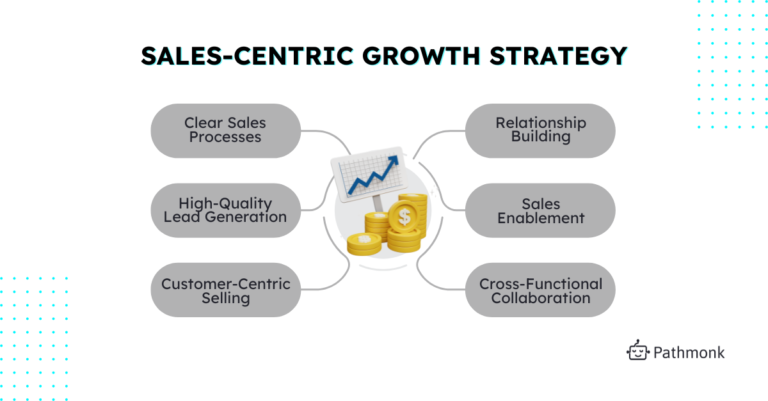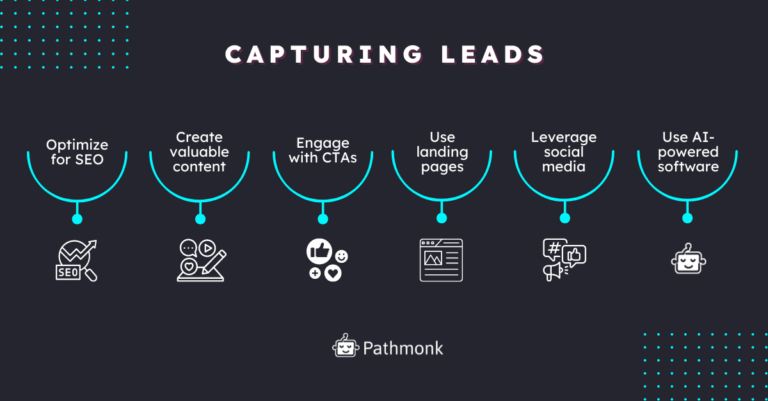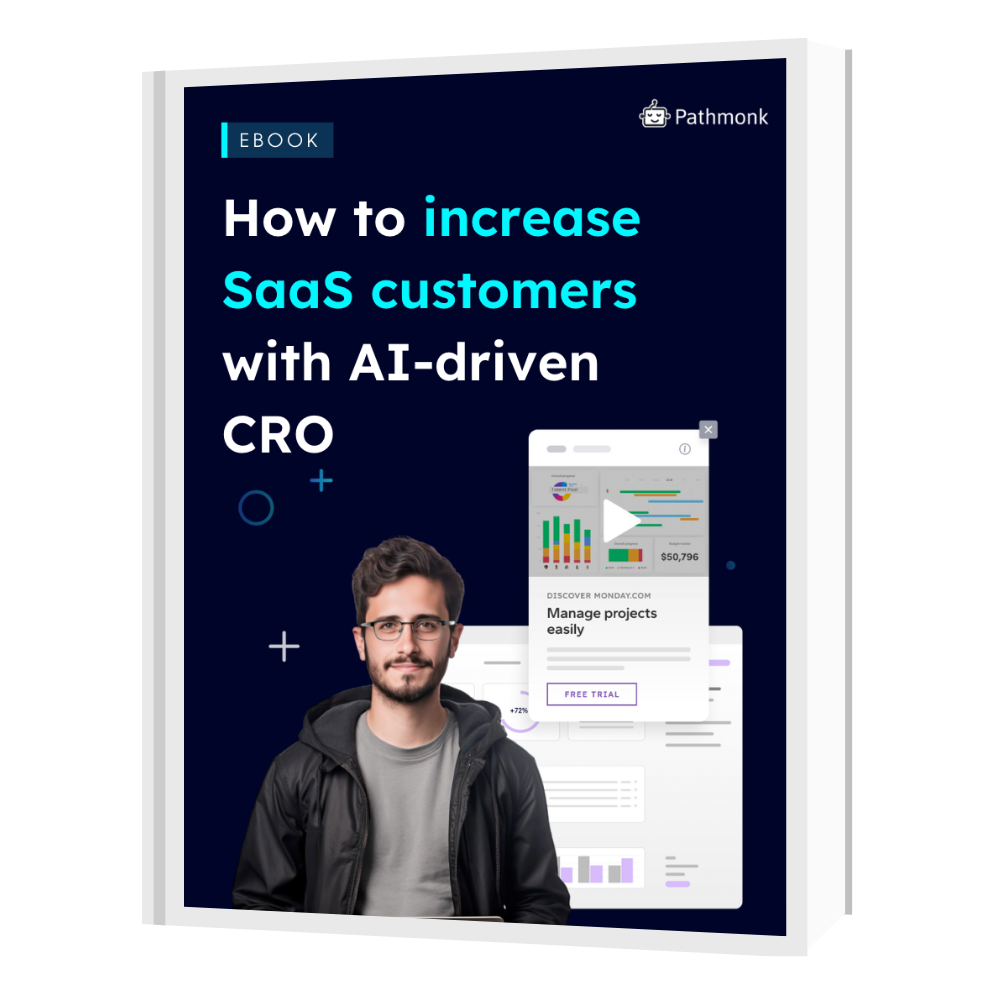
When it comes to marketing strategies, there’s one mantra I always tell my friends and colleagues: if it doesn’t lead to sales, it’s just noise.
You can have the flashiest website, the most engaging content, and a social media presence that puts influencers to shame, but if it’s not turning visitors into customers, then what’s the point? The good news is that this is now easier than ever before with the help of AI.
But if there’s one thing a sales-led growth model needs, it’s having sales and marketing perfectly aligned. A study from MarketingProfs showed that companies with aligned sales and marketing teams achieve 208% higher marketing revenue than those that don’t. This is definitely a wake-up call to focus on strategies that marry these two crucial functions seamlessly and efficiently.
In this article we will cover how you can develop and optimize your sales-centric strategy, and how AI can help you improve results automatically.
Table of Contents
What Is a Sales-Centric Growth Strategy?
A sales-centric marketing strategy, also known as sales-led growth model, prioritizes the sales function as the primary driver of business growth. This approach emphasizes direct sales efforts, sales team capabilities, and a structured sales process to achieve revenue goals.
Simply put, a sales-led growth strategy should incorporate these elements:
Clear Sales Processes
Develop a well-defined sales process that guides prospects through the sales funnel, from lead generation to closing deals. This structured approach ensures consistency and efficiency, allowing your sales team to focus on converting leads into customers.
Contrary to a product-led growth strategy, prospects in a sales-led model require direct interaction with sales representatives to understand the value proposition and make informed purchasing decisions.
A clear process includes stages like initial contact, needs assessment, solution presentation, handling objections, and closing the deal.
Targeted High-Quality Lead Generation
Focus on generating high-quality leads through various channels such as outbound prospecting, inbound marketing, referrals, and events. Use data and insights to identify and target the most promising prospects. This means investing in tools and technologies that help you track lead behavior, segment your audience, and personalize outreach efforts.
High-quality leads are those who are more likely to convert based on their behavior, engagement level, and fit with your ideal customer profile.
Customer-Centric Selling
Understand the needs, pain points, and goals of your customers. Tailor your sales approach to address these needs and demonstrate how your product or service can provide value and solve their problems. This involves active listening, asking the right questions, and presenting your solution in a way that aligns with the customer’s unique challenges and objectives.
A customer-centric approach builds trust and positions your sales team as problem solvers rather than just sellers.
Relationship Building
Build strong, long-term relationships with prospects and customers. This involves regular follow-ups, personalized communication, and a consultative selling approach that positions your sales team as trusted advisors.
Effective relationship building goes beyond the initial sale; it includes ongoing engagement, customer satisfaction initiatives, and proactive support to ensure customers feel valued and supported throughout their journey with your company.
Sales Enablement
Marketing should provide your sales team with the tools, content, and materials they need to be successful. This includes resources such as sales scripts, product information, case studies, and competitive analysis.
Sales enablement also involves training and development programs to enhance the skills and knowledge of your sales team. The goal is to equip your salespeople with everything they need to effectively communicate the value of your product or service and close deals.
Cross-Functional Collaboration
Ensure alignment and collaboration between sales and other departments such as marketing, customer success, and product development. This helps create a seamless customer experience and supports overall business goals.
Cross-functional collaboration ensures that all teams are working towards common objectives and that insights from each department are leveraged to improve the sales process. Regular meetings, shared goals, and integrated systems are key to fostering this collaboration.

How to Create a Sales-Centric Marketing Strategy
Creating a sales-centric marketing strategy involves a structured approach that aligns your marketing efforts with your sales goals. Here’s a step-by-step guide to get you started.
Define Goals
The first step in any strategy is to define clear, measurable goals. What do you want to achieve? Are you looking to increase sales by a certain percentage, grow your customer base, or boost customer retention? Having specific goals will help you focus your efforts and measure your success.
For example, a goal could be: “Increase online sales by 20% in the next six months.” This goal is specific, measurable, attainable, relevant, and time-bound (SMART). Once you have your goals in place, you can break them down into smaller, actionable objectives that will guide your strategy.
Structure/Map Your Sales Funnels and Touchpoints
Next, you need to map out your sales funnel and identify all the touchpoints you want to incorporate. The sales funnel is the journey your prospects take from the moment they become aware of your brand to the point they make a purchase (and beyond). Understanding this journey is crucial to creating a strategy that effectively guides prospects through each stage.
- Awareness: How will potential customers learn about your brand? This could be through SEO, social media, content marketing, or paid advertising.
- Interest: Once they’re aware, how will you capture their interest? Engaging content, informative webinars, and compelling offers can keep them interested.
- Consideration: At this stage, prospects are evaluating their options. Provide detailed information, comparisons, and case studies to help them see the value in your product or service.
- Decision: Make it easy for prospects to take the final step. Clear CTAs, easy navigation, and strong social proof can help convert interest into action.
- Post-Purchase: The journey doesn’t end at the purchase. Follow up with excellent customer service, personalized recommendations, and loyalty programs to keep customers engaged and coming back.
Mapping these stages and touchpoints will help you create a seamless and cohesive experience for your customers.
Understand Your Audience and Segment Appropriately
A deep understanding of your audience is vital for any marketing strategy. You need to know who your customers are, what they need, and how they behave. This involves conducting thorough market research to gather demographic data, behavioral insights, and customer feedback.
Once you have this information, segment your audience into different groups based on characteristics such as age, location, buying behavior, and interests. This segmentation allows you to tailor your marketing efforts to each group more effectively.
For example, if you have a segment of young professionals who are tech-savvy, you might use social media and email marketing to reach them. For another segment of older, more traditional buyers, you might focus on content marketing and direct mail. The goal is to approach each segment with personalized messages that resonate with their specific needs and preferences.
Capturing Leads
Capturing leads is a critical part of your sales-centric marketing strategy. You need to attract potential customers and gather their information so you can nurture them through the sales funnel.
- Optimize for SEO: ensure your website and content are easily discoverable through search engines. Use relevant keywords, meta descriptions, and high-quality content to rank higher in search results.
- Create valuable content: offer content that addresses your audience’s pain points and provides solutions. This could be blog posts, e-books, webinars, or infographics. Make sure your content is engaging and informative.
- Engage with CTAs: use clear and compelling calls-to-action throughout your website and content. Encourage visitors to subscribe to your newsletter, download a free resource, or request a demo.
- Use landing pages: develop dedicated landing pages for specific campaigns or offers. These pages should have a single focus and a clear path to conversion, with minimal distractions.
- Leverage social media: use social media platforms to promote your content and engage with your audience. Social media can be a powerful tool for driving traffic to your website and capturing leads.
- Use AI-powered software for personalization: AI-powered personalization helps companies increase the number and quality of generated leads. With advanced data analytics, and other contextual information gathered, Pathmonk allows the identification of the prospects with a higher change of conversion. Increase the efficiency of your sales team by investing their capabilities when and where they will be most likely to sell.

How to Measure the Success of Your Sales-Centric Strategy
A strategy is only as good as its results. Measuring the success of your sales-centric strategy involves tracking key metrics:
- Conversion rate: the percentage of visitors who take the desired action. This could be filling out a form, making a purchase, or signing up for a newsletter. Regularly analyze your conversion rates to identify trends and areas for improvement. Use tools like Google Analytics to track conversion paths and understand user behavior.
- Customer acquisition cost (CAC): the cost associated with acquiring a new customer. This includes marketing expenses, sales expenses, and any other costs involved. Calculate your CAC by dividing the total costs of acquisition by the number of new customers gained. Monitor this metric to ensure your marketing efforts are cost-effective and sustainable.
- Customer lifetime value (CLTV): the total revenue you can expect from a customer over their lifetime. A higher CLTV means your strategy is effective in retaining customers. Calculate CLTV by multiplying the average purchase value, purchase frequency, and customer lifespan. Use this metric to guide your investment in customer retention efforts and identify your most valuable customer segments.
- Return on marketing investment (ROMI): The revenue generated from marketing activities compared to the cost of those activities. Calculate ROMI by dividing the revenue attributed to marketing efforts by the total marketing costs. Track this metric to evaluate the effectiveness of your marketing campaigns and optimize your budget allocation.
Transform your SaaS CRO strategy with AI
Dive deep into the latest AI-powered trends and gain a competitive edge in the SaaS industry.

Unique Attributes of a Successful Sales-Centric Website
Assuming your website is already up and running, here are some unique attributes to integrate into your website to create a more engaging, personalized, and effective user experience that drives conversions and supports your sales-centric marketing strategy. Remember, the goal is to make it as easy and compelling as possible for visitors to become loyal customers.
- Gamification elements: introducing gamification elements such as progress bars, achievement badges, or point systems can enhance user engagement. For instance, offer rewards or discounts as visitors complete certain actions on your site, like reading blog posts or filling out forms. This creates a fun, interactive experience that motivates users to stay engaged and convert.
- Micro-interactions: these are small, subtle animations or design elements that respond to user actions, providing instant feedback and enhancing user experience. For example, buttons that change color when hovered over, animated form submissions, or visual confirmations when adding items to a cart can make your site feel more interactive and engaging.
- Advanced filtering and search options: help visitors find exactly what they’re looking for quickly with advanced search and filtering capabilities. Use AI-driven search tools that predict user intent and offer auto-suggestions. Filtering options should allow users to narrow down products or content based on various criteria, such as price range, features, or popularity.
- Interactive product demos: instead of static images or videos, consider offering interactive product demos. These can include 360-degree views, augmented reality (AR) experiences, or virtual try-ons for products like clothing or accessories. This interactive element helps customers better understand and connect with the product, increasing the likelihood of purchase.
- Predictive personalization: leverage predictive analytics to personalize the user experience in real-time. Based on user behavior and historical data, predict what products or content they might be interested in and adjust the website dynamically to highlight these recommendations. This level of personalization can significantly enhance engagement and conversion rates.
Using Predictive Analytics to Boost Conversion Rates
As seen above, most of the unique features that make a sales centric website successful require advanced analytics and predictive capabilities. Predictive analytics can be a game-changer for your sales-centric marketing strategy. By analyzing historical data, you can predict future behaviors and trends, allowing you to make informed decisions.
By incorporating predictive analytics into your website, you now have the power to track users on their buying behavior, both on your website and out, thanks to Pathmonk’s cookieless analytics. With this valuable data, you can create personalized interactions, content and recommendations. The sky’s the limit!
Increase +180%
leads
demos
sales
bookings
from your website with AI
Get more conversions from your existing website traffic delivering personalized experiences.

By focusing on capturing, nurturing, and converting leads, and fostering customer loyalty, you can build a robust strategy that drives real results. Remember to measure your success with Intelligence and continuously optimize your efforts.
So, next time you sip your coffee (or wine), take a moment to reflect on your current strategy. Are you just making noise, or are you driving sales? The choice is yours. And trust me, when you get it right, the results will speak for themselves. Cheers to creating a sales-centric marketing strategy that rocks!





